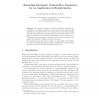Free Online Productivity Tools
i2Speak
i2Symbol
i2OCR
iTex2Img
iWeb2Print
iWeb2Shot
i2Type
iPdf2Split
iPdf2Merge
i2Bopomofo
i2Arabic
i2Style
i2Image
i2PDF
iLatex2Rtf
Sci2ools
LATA
2010
Springer
2010
Springer
Extending Stochastic Context-Free Grammars for an Application in Bioinformatics
We extend stochastic context-free grammars such that the probability of applying a production can depend on the length of the subword that is generated from the application and show that existing algorithms for training and determining the most probable parse tree can easily be adapted to the extended model without losses in performance. Furthermore we show that the extended model is suited to improve the quality of predictions of RNA secondary structures. The extended model may also be applied to other fields where SCFGs are used like natural language processing. Additionally some interesting questions in the field of formal languages arise from it.
Automata Theory | Extended Model | LATA 2010 | Probable Parse Tree | Stochastic Context-free Grammars |
| Added | 28 May 2010 |
| Updated | 28 May 2010 |
| Type | Conference |
| Year | 2010 |
| Where | LATA |
| Authors | Frank Weinberg, Markus E. Nebel |
Comments (0)

